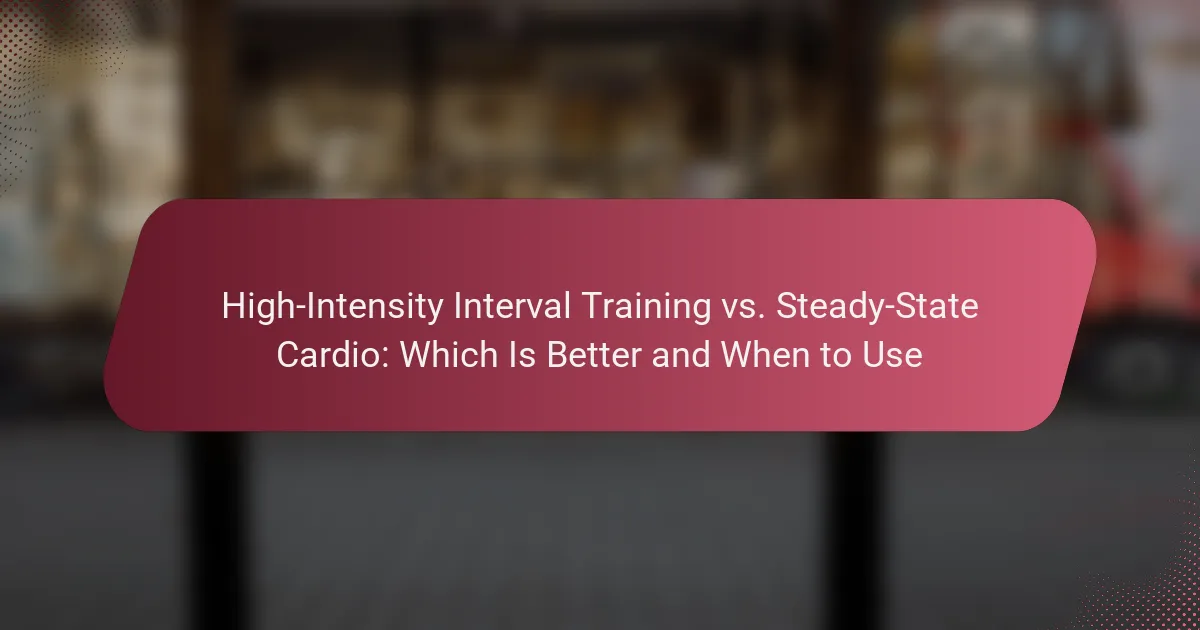High-Intensity Interval Training (HIIT) and steady-state cardio each offer unique benefits, making them suitable for different fitness goals and schedules. HIIT is particularly effective for fat loss and maximizing workout efficiency in a shorter time, while steady-state cardio is ideal for longer sessions with a focus on lower injury risk and consistent intensity. Understanding when to use each method can help you tailor your fitness routine to achieve optimal results.
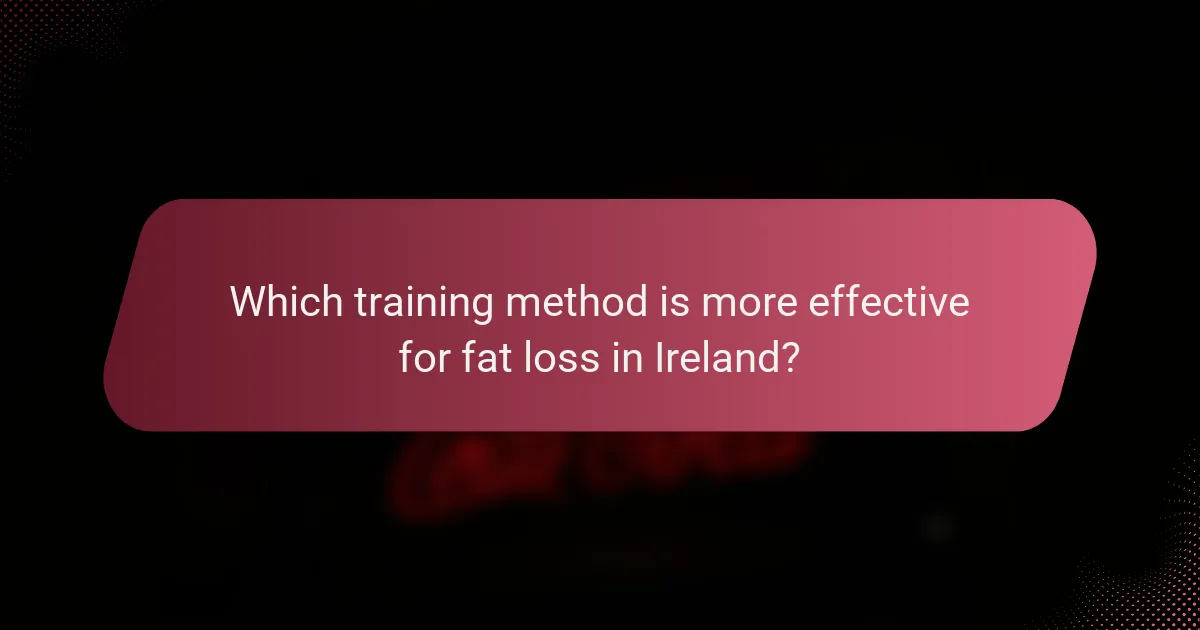
Which training method is more effective for fat loss in Ireland?
High-Intensity Interval Training (HIIT) is often considered more effective for fat loss compared to steady-state cardio, especially in Ireland. HIIT can lead to greater calorie burn in a shorter time, while steady-state cardio promotes fat oxidation over longer durations.
High-Intensity Interval Training (HIIT) burns more calories post-exercise
HIIT involves short bursts of intense activity followed by rest or low-intensity periods. This method can significantly elevate your metabolic rate even after the workout has ended, a phenomenon known as excess post-exercise oxygen consumption (EPOC). Studies suggest that HIIT can increase calorie burn by up to 15% in the hours following a session.
For example, a 20-minute HIIT workout can burn as many calories as a longer steady-state session. Incorporating exercises like sprinting, cycling, or bodyweight movements can maximize the effectiveness of HIIT. Aim for intervals of 30 seconds of high effort followed by 1-2 minutes of rest.
Steady-State Cardio promotes sustained fat oxidation
Steady-state cardio involves maintaining a consistent, moderate intensity over a longer period. This approach is effective for promoting fat oxidation, as the body primarily uses fat as fuel during prolonged, low to moderate-intensity exercise. Activities such as jogging, cycling, or swimming for 30-60 minutes can be beneficial.
While steady-state cardio may not burn as many calories post-exercise as HIIT, it can be easier to sustain for longer durations, making it a good option for building endurance. For those new to exercise or with specific health considerations, steady-state cardio can be a safer and more manageable choice.
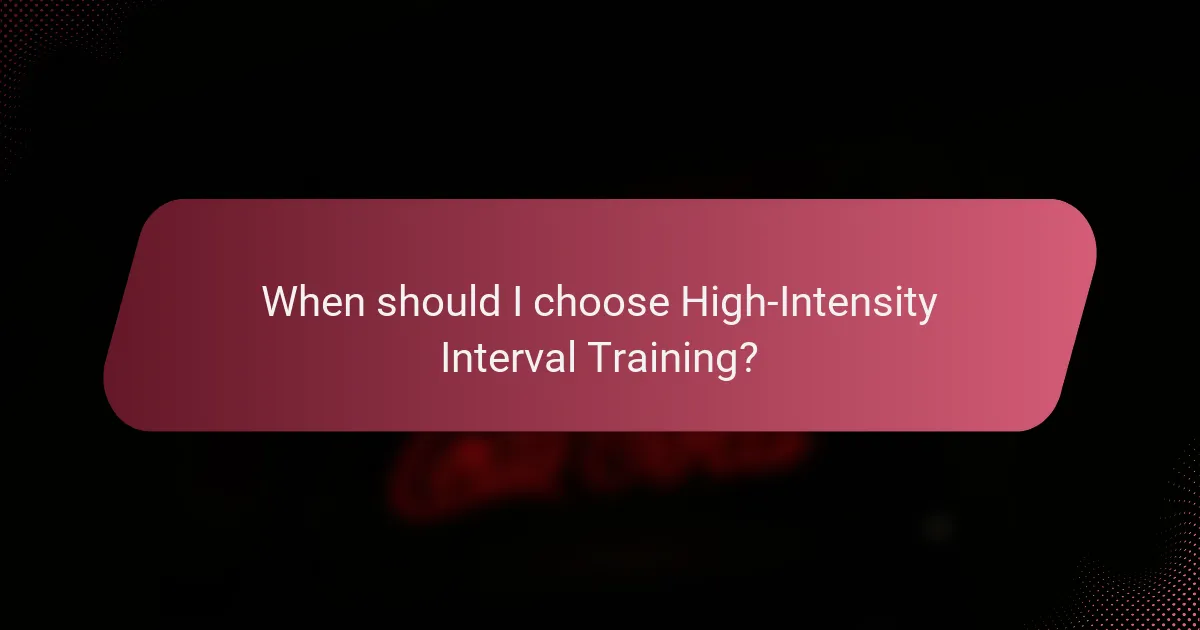
When should I choose High-Intensity Interval Training?
High-Intensity Interval Training (HIIT) is ideal when you have limited time and want to maximize your workout efficiency. This training method alternates between short bursts of intense activity and recovery periods, allowing for significant fitness gains in a shorter duration compared to traditional steady-state cardio.
Short time availability
If you have a busy schedule, HIIT is a practical choice. A typical session can last anywhere from 15 to 30 minutes, making it easier to fit into your day. For instance, a quick workout could include 20 seconds of sprinting followed by 40 seconds of walking, repeated for 15 minutes.
To make the most of your limited time, aim for at least two to three HIIT sessions per week. This frequency can help you maintain cardiovascular health and improve endurance without requiring lengthy gym visits.
Desire for rapid fitness improvements
HIIT is effective for those looking to see quick results in their fitness levels. The intense nature of the workouts can lead to improvements in both aerobic and anaerobic capacity, often within a few weeks. This method can also enhance metabolic rate, helping with fat loss more efficiently than steady-state cardio.
To optimize your progress, incorporate a variety of exercises in your HIIT routine, such as cycling, running, or bodyweight movements. This variety not only keeps workouts engaging but also targets different muscle groups, contributing to overall fitness improvements.
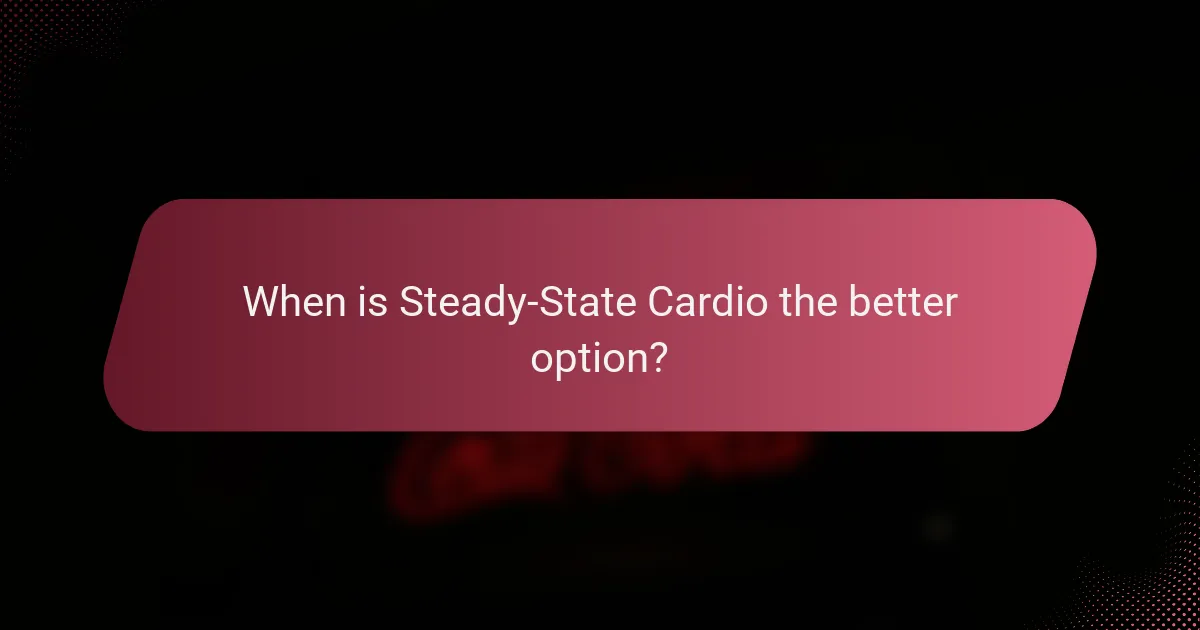
When is Steady-State Cardio the better option?
Steady-state cardio is often the better choice when you have longer workout sessions available and are looking for a lower injury risk, especially for beginners. This form of exercise involves maintaining a consistent intensity over an extended period, making it suitable for various fitness levels.
Longer workout sessions available
Steady-state cardio is ideal for longer workout sessions, typically lasting from 30 minutes to over an hour. This duration allows individuals to build endurance gradually without overwhelming their bodies. Activities like jogging, cycling, or swimming at a moderate pace can be sustained for extended periods, making them effective for fat burning and cardiovascular health.
When planning longer sessions, aim for a heart rate that is about 50-70% of your maximum. This range is generally manageable and allows for conversation while exercising, which is a good indicator of the right intensity.
Lower injury risk for beginners
For beginners, steady-state cardio presents a lower injury risk compared to high-intensity workouts. The gradual pace reduces the likelihood of strain or overexertion, making it easier to adapt to a new fitness routine. Starting with activities like brisk walking or light cycling can help build a solid foundation.
To minimize injury risk, beginners should focus on proper form and listen to their bodies. Incorporating rest days and cross-training can also help prevent overuse injuries while allowing for recovery and adaptation to the exercise regimen.

What are the key differences between HIIT and Steady-State Cardio?
High-Intensity Interval Training (HIIT) and Steady-State Cardio differ primarily in their intensity and structure. HIIT involves short bursts of intense activity followed by rest or low-intensity periods, while steady-state cardio maintains a consistent, moderate effort throughout the workout.
Intensity levels
HIIT workouts are characterized by their high intensity, often reaching 80-90% of maximum heart rate during the intense intervals. In contrast, steady-state cardio typically operates at a lower intensity, around 50-70% of maximum heart rate, allowing for sustained effort over longer periods.
The choice between these intensity levels can affect your fitness goals. HIIT is effective for improving cardiovascular fitness and burning calories in a shorter time, while steady-state cardio is beneficial for endurance and can be easier on the joints.
Duration and frequency
HIIT sessions are generally shorter, lasting around 15-30 minutes, but can be very demanding. Due to their intensity, it’s recommended to perform HIIT workouts 2-3 times per week to allow for adequate recovery. On the other hand, steady-state cardio can last anywhere from 30 minutes to an hour and can be done more frequently, up to 5-6 times a week, depending on your fitness level.
When planning your workout routine, consider your schedule and recovery needs. If time is limited, HIIT may provide a more efficient workout, while steady-state cardio can be integrated into longer sessions for those looking to build endurance without excessive strain.
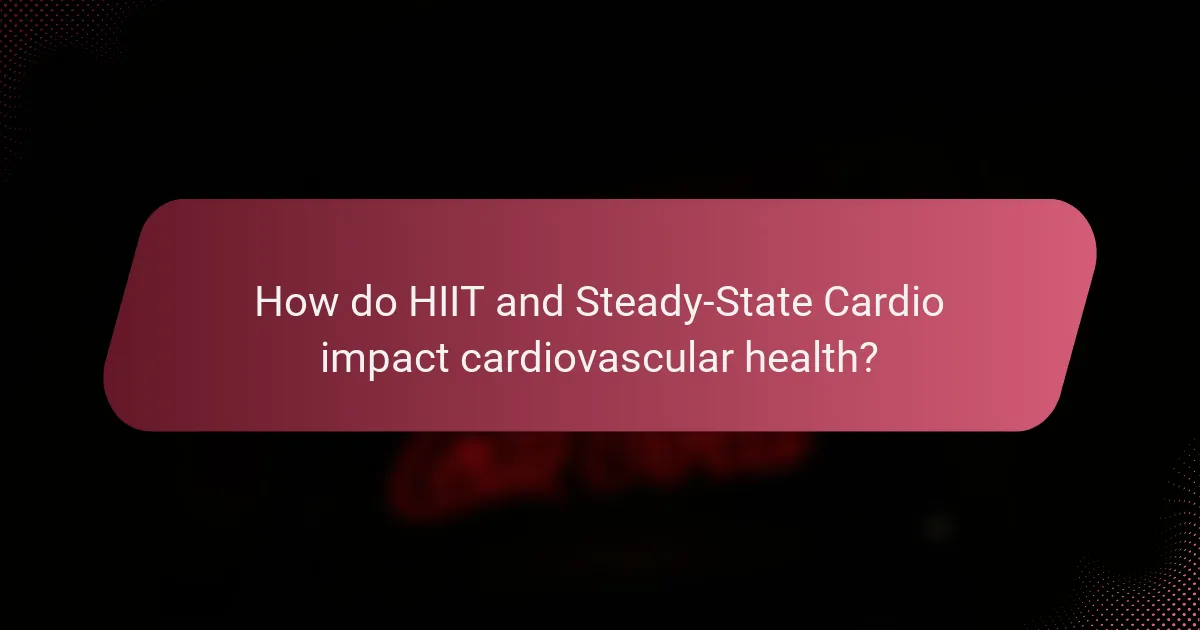
How do HIIT and Steady-State Cardio impact cardiovascular health?
HIIT and steady-state cardio both positively influence cardiovascular health, but they do so in different ways. HIIT provides efficient heart health benefits through short bursts of intense activity, while steady-state cardio focuses on building endurance over longer periods.
HIIT improves heart health efficiently
High-Intensity Interval Training (HIIT) enhances cardiovascular health by pushing the heart to work at maximum capacity for brief intervals, followed by rest or low-intensity periods. This approach can lead to improved heart function and increased aerobic capacity in a shorter time than traditional workouts.
Studies suggest that engaging in HIIT for about 20-30 minutes, a few times a week, can yield significant cardiovascular benefits. For example, a typical HIIT session may include 30 seconds of sprinting followed by 1-2 minutes of walking, repeated several times.
Steady-State Cardio enhances endurance
Steady-state cardio involves maintaining a consistent, moderate intensity over an extended duration, which effectively builds endurance and stamina. Activities like jogging, cycling, or swimming for 30-60 minutes at a steady pace can improve heart health and overall fitness.
This type of training is beneficial for those looking to increase their aerobic capacity gradually. It is often recommended to engage in steady-state cardio for at least 150 minutes per week, as per guidelines from health organizations. A common pitfall is overtraining; ensure to include rest days to allow the body to recover and adapt.
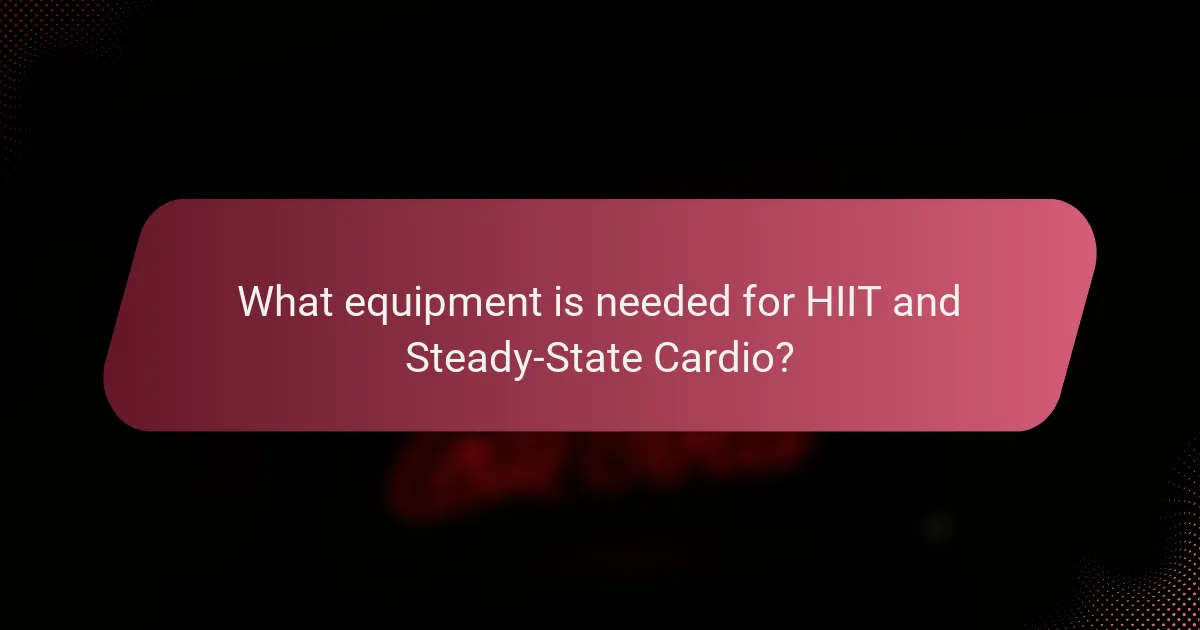
What equipment is needed for HIIT and Steady-State Cardio?
High-Intensity Interval Training (HIIT) typically requires minimal equipment, while Steady-State Cardio can utilize a variety of machines and tools. The choice of equipment can significantly influence the effectiveness and enjoyment of your workouts.
Minimal equipment for HIIT
HIIT workouts can be performed with little to no equipment, making them accessible for most people. Common options include bodyweight exercises like burpees, jump squats, and push-ups, which can be done anywhere.
If you prefer using equipment, options like kettlebells, dumbbells, or resistance bands can enhance your HIIT sessions. These tools add variety and intensity, allowing for a more challenging workout.
Variety of equipment for Steady-State Cardio
Steady-State Cardio often involves a range of equipment to maintain a consistent pace over time. Popular choices include treadmills, stationary bikes, elliptical machines, and rowing machines, each providing unique benefits.
When selecting equipment for Steady-State Cardio, consider your fitness goals and preferences. For example, treadmills are great for running or walking, while stationary bikes are ideal for low-impact workouts. Mixing different machines can help prevent boredom and improve overall fitness.
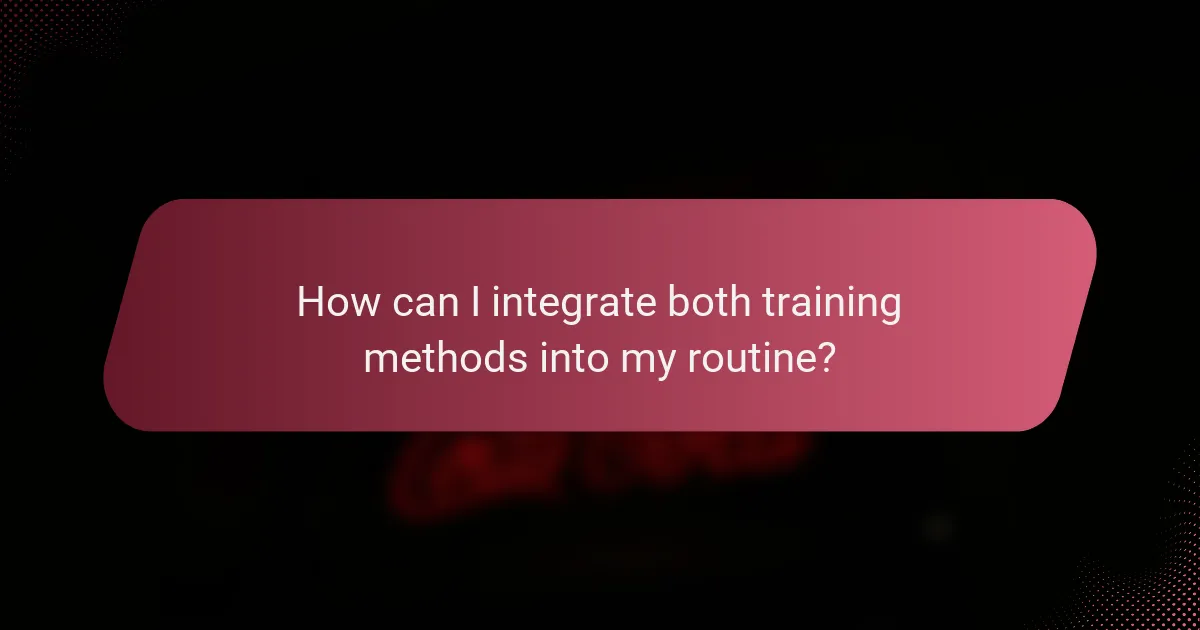
How can I integrate both training methods into my routine?
Integrating high-intensity interval training (HIIT) and steady-state cardio into your routine can enhance overall fitness and prevent workout monotony. A balanced approach allows you to reap the benefits of both methods while minimizing the risk of overtraining.
Weekly workout schedule
A well-structured weekly workout schedule can help you effectively combine HIIT and steady-state cardio. For instance, you might allocate three days for HIIT sessions, focusing on short bursts of intense activity followed by recovery periods, and two to three days for steady-state cardio, such as jogging or cycling at a moderate pace.
Consider a sample schedule: Monday and Thursday for HIIT, Tuesday and Saturday for steady-state cardio, and Wednesday for active recovery, like yoga or walking. This setup allows for adequate recovery while maximizing the benefits of both training styles.
Balancing intensity and recovery
Balancing intensity and recovery is crucial when integrating HIIT and steady-state cardio. HIIT workouts are demanding and require sufficient recovery time to prevent fatigue and injury. Aim for at least 48 hours between intense HIIT sessions to allow your body to recover adequately.
In contrast, steady-state cardio can be performed more frequently, as it is less taxing on the body. However, listen to your body and adjust your schedule based on how you feel. Incorporating rest days and lighter activities will help maintain your overall performance and motivation.
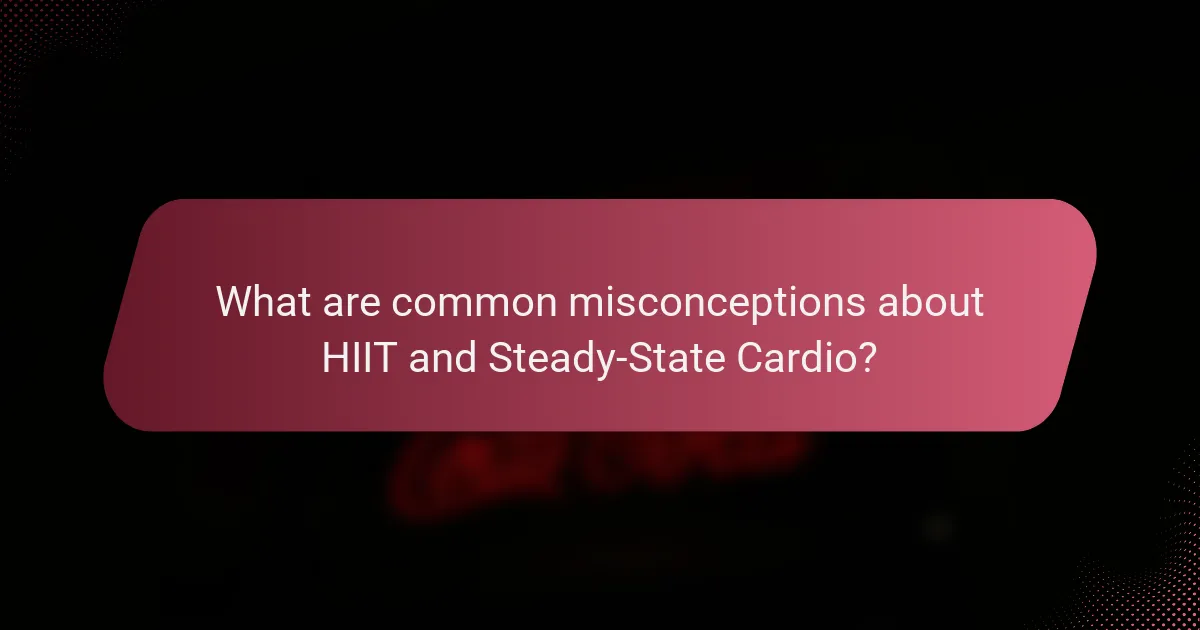
What are common misconceptions about HIIT and Steady-State Cardio?
Many people hold misconceptions about High-Intensity Interval Training (HIIT) and steady-state cardio, often leading to confusion about their effectiveness and suitability. Understanding these misconceptions can help individuals choose the right training method for their fitness goals.
HIIT is only for advanced athletes
A common belief is that HIIT is exclusively for advanced athletes, but this is not true. HIIT can be adapted for all fitness levels, from beginners to seasoned athletes. Starting with shorter intervals and longer rest periods allows newcomers to gradually build their endurance and strength.
For beginners, a simple approach could include alternating between 20 seconds of moderate effort and 40 seconds of rest. As fitness improves, the intensity and duration of the work intervals can be increased.
Steady-State Cardio is ineffective for weight loss
Another misconception is that steady-state cardio is ineffective for weight loss, but it can be a valuable component of a weight loss strategy. While HIIT may burn more calories in a shorter period, steady-state cardio can be sustained for longer durations, leading to significant calorie expenditure over time.
For effective weight loss, incorporating steady-state cardio sessions of 30 to 60 minutes several times a week can complement a balanced diet. Activities like jogging, cycling, or swimming at a moderate pace can help maintain a caloric deficit necessary for weight loss.
